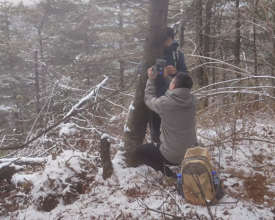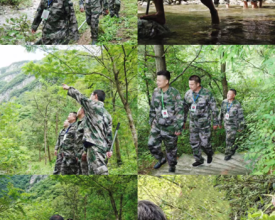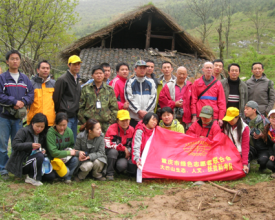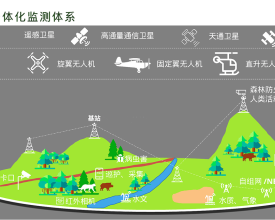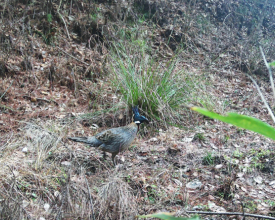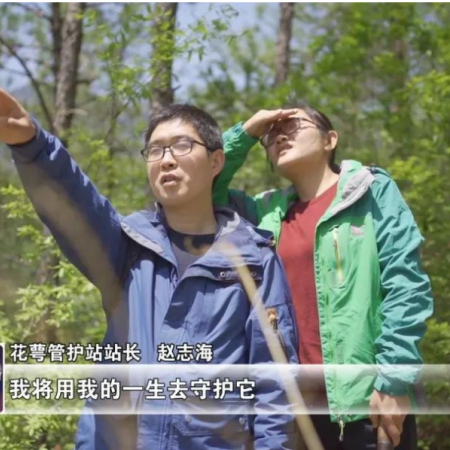
Sichuan Hua'e Mountain National Nature Reserve: Integrated Strategies Guarding the "Species Refuge"
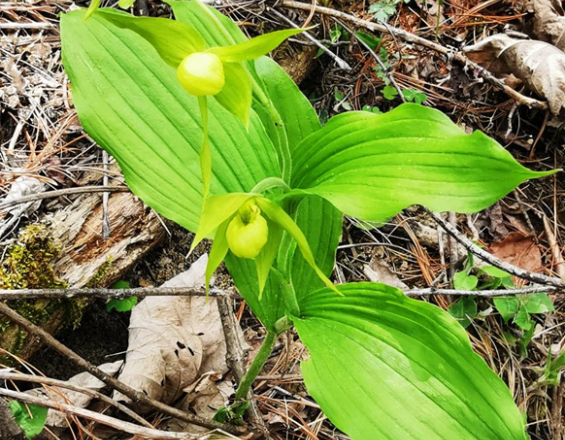
Sichuan Hua'e Mountain National Nature Reserve, confronting severe challenges in biodiversity conservation, has implemented an integrated species conservation solution that combines scientific research, habitat protection, targeted species conservation, and community participation. Grounded in comprehensive baseline resource surveys, the solution safeguards species habitats through a coordinated system of "Zoned Management + Community Patrols + Digital Surveillance". It carries out specialized conservation programs for very small populationsand rare species, such as Thuja sutchuenensis , Cypripedium henryi , and incorporates sustainable community livelihood projects to mitigate conservation-development conflicts. The core value of this solution lies in its systematic, adaptive, and collaborative nature. It has not only ensured the survival security of 2,825 vascular plant species and 414 vertebrate species within the reserve but also provides a replicable model for biodiversity conservation in other similar nature reserves.
Context
Challenges addressed
- Pressure on Rare Species: The reserve is home to 4 plant species under National Class I protection and 24 under Class II protection, as well as 4 animal species under National Class I key protection and 26 under Class II. These species often have limited population sizes and narrow distributions, making them vulnerable to disturbances.
- Habitat Disturbance Risks: As the source and watershed of two major tributaries (Hanjiang and Jialingjiang) of the upper Yangtze River, its ecosystem services are critically important yet fragile, facing potential pressures from human activities.
- Capacity Building Needs: An imbalance exists between the vast protected area (46,534.37 hectares) and the limited management resources, necessitating more efficient conservation management systems.
- Community Development Pressures: Potential conflicts exist between traditional livelihoods of communities in and around the reserve and species conservation, requiring a balance between ecological protection and community development.
Location
Process
Summary of the process
The scientific monitoring system serves as the "brain," continuously collecting data through infrared camera networks, species censuses, and ecological assessments to accurately identify biodiversity hotspots and threat factors. These scientific findings directly guide habitat protection and species conservation measures—the "arms" of protection—enabling more targeted patrol route planning and more precise rescue conservation such as the Thuja reintroduction program. The community co-management mechanism acts as the system’s "heart," deeply integrating alternative livelihoods like Fritillaria eco-agriculture with conservation goals, incentivizing residents to become ecological rangers and building a win-win situation for both protection and development. Field observations feedback from community residents continually enrich scientific understanding, creating a self-improving cycle from monitoring and assessment to precise intervention and community participation. This organically integrated collaborative model achieves a sustainable balance between ecological conservation and community development through scientific empowerment, targeted measures, and benefit-sharing.
Building Blocks
Système complet d'études et de surveillance scientifiques
1. études de base systématiques : La réserve a révisé et amélioré son plan directeur et a compilé le "Hua'e Mountain Biodiversity Scientific Investigation Report", documentant systématiquement les informations sur les espèces afin d'informer la conservation ciblée.
2. un suivi spécialisé régulier : En collaboration avec de nombreux instituts de recherche, la réserve mène en permanence des enquêtes spécialisées, notamment sur les amphibiens, la diversité des oiseaux et les plantes herbacées.
3) Méthodes de surveillance technologique : La réserve utilise des méthodes avancées telles que la surveillance vidéo, les caméras infrarouges, les patrouilles manuelles améliorées, les caméras infrarouges couleur nocturnes et les colliers GPS pour la faune afin de surveiller la dynamique des espèces.
Système de protection de l'habitat à plusieurs niveaux
1.Stratégie de gestion du zonage : La réserve est divisée en zones centrale, tampon et expérimentale, et des mesures de gestion différenciées sont appliquées en conséquence.
2. réseau de protection coordonné : Mise en place d'un réseau de protection tridimensionnel "gestion par zones + patrouilles communautaires + surveillance numérique" pour garantir la sécurité des ressources forestières.
3) Mécanisme de patrouille : Quatre postes de gestion de base à l'intérieur de la réserve, dotés de 5 à 6 patrouilleurs, adhèrent au modèle de travail "plans mensuels, affectations quotidiennes et résumés en milieu de mois" pour les patrouilles de routine.
Mesures de conservation ciblées pour les espèces rares
1) Découverte et documentation d'espèces rares : Grâce à une surveillance régulière, de nouvelles espèces sont continuellement découvertes, comme les premiers enregistrements photographiques des plantes de classe II protégées au niveau national, Cypripedium henryi (绿花杓兰) et Cypripedium japonicum (扇脉杓兰) en 2025, et le premier enregistrement de la faune de classe II protégée au niveau national, Pucrasia macrolopha (勺鸡), en 2025.
2. développement d'une plateforme de recherche scientifique : Collabore avec des institutions telles que l'Université des arts et des sciences du Sichuan pour construire des plateformes de recherche, avec des plans pour établir des stations d'observation à long terme sur le terrain, de grandes parcelles de communautés écologiques et des stations de surveillance environnementale.
Participation communautaire et moyens de subsistance durables
1. mise en place de mécanismes de cogestion : La réserve et les communautés environnantes ont établi conjointement un comité de cogestion communautaire, créant ainsi une plateforme de communication et de collaboration sans heurts. Grâce à des réunions conjointes régulières, ils formulent et mettent en œuvre collectivement des plans de gestion des ressources naturelles, en veillant à ce que les communautés aient le droit d'être informées, de participer et de superviser les questions de conservation et de développement.
2. l'éducation à la nature et la sensibilisation à l'écologie : Accueille activement des équipes de recherche et d'investigation thématiques totalisant plus de 100 000 participants de l'intérieur et de l'extérieur de la province, promouvant son rôle en tant que deuxième groupe de camps verts nationaux d'éducation à la nature pour la jeunesse du Sichuan.
Impacts
- Steady Improvement in Biodiversity, Rare Species Populations Recovering Stably:The reserve continues to document new species records, including first sightings of Cypripedium henryi, Cypripedium japonicum, and Pucrasia macrolopha. Infrared cameras consistently monitor key protected species like Moschus berezovskii, Naemorhedus griseus, and Capricornis milneedwardsii in healthy conditions, with stable populations.
- Ecosystem Integrity Maintained, Service Functions Continuously Enhanced:The reserve maintains a complete natural ecosystem, providing effective protection for numerous ancient and rare species. Monitoring shows continuous improvement in biodiversity richness, with intact ecosystem structure and function. Key ecological services including water conservation and soil retention are consistently maintained.
- Management Efficiency Significantly Enhanced, Collaborative Governance Achieves Remarkable Results:The "Zoned Management + Community Patrols + Digital Surveillance" system significantly improved conservation efficiency. Deep collaboration with research institutions enhanced scientific monitoring and decision-making capabilities. This collaborative governance model effectively supports ecological conservation outcomes and establishes a solid foundation for addressing future challenges.
Beneficiaries
Local Communities and Residents;
Scientific Research and Education Institutions;
Regional Society and Green Economy;
Global Society and Future Generations。
Global Biodiversity Framework (GBF)
Sustainable Development Goals
Story

In 2009, driven by idealism to serve western China, Zhao Zhihai arrived in Wanyuan, Sichuan through the University Student Volunteer Service "West China Program." After five years of grassroots experience, he joined the Sichuan Hua'e Mountain National Nature Reserve in 2014, starting as an office secretary. However, his profound commitment to ecological conservation led him to volunteer in 2018 for frontline duty at the reserve's most remote Hua'e Management Station, where he began his true mountain guardianship journey alongside his wife, Gong Dengju.
At the Hua'e Management Station, Zhao Zhihai and his colleagues measured this 67-square-kilometer pristine mountain forest with their footsteps. Day after day, they patrolled to prevent ecological damage from activities like bamboo shoot harvesting in core protection zones, while also monitoring forest fire safety and setting up infrared sensor cameras to track wildlife. Their persistence over five years—accumulating over 800 patrols and more than 10,000 kilometers on foot—yielded invaluable firsthand data: active traces of nationally first-class protected species like golden eagles (Aquila chrysaetos) and forest musk deer (Moschus berezovskii), along with survival status documentation of second-class protected species including golden pheasants (Chrysolophus pictus), Temminck's tragopans (Tragopan temminckii), northern goshawks (Accipiter gentilis), serows (Capricornis sumatraensis), and gorals (Naemorhedus griseus). These discoveries have become crucial indicators for assessing the reserve's ecosystem health.
Far from urban amenities, Zhao Zhihai's family found their unique happiness in the mountains. The birth of their child in 2019 filled this guardian's home with laughter and joy. The vegetable garden he cultivated behind their house not only provided fresh produce but embodied his deep affection for this land. "Despite being far from the city, with hard work and life inconveniences, my wife and I truly love our current life," Zhao reflects. "As an ecology graduate, Hua'e Mountain is both my textbook and a vast ocean of knowledge."
Today, this professionally trained guardian combines his academic background with field experience, dedicating himself to plant classification research while planning to pass on his patrolling methodologies to younger generations.


